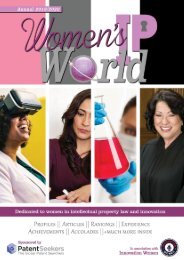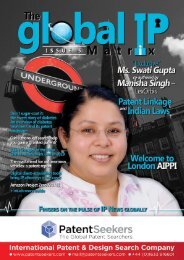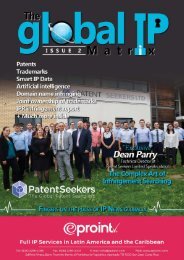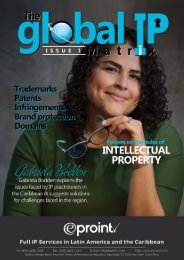Global IP Matrix - Issue 6
HAPPY NEW YEAR 2020 to all our readers. It has been a fantastic year for The Global IP Matrix, and 2020 is shaping up to become an even bigger and productive year for us. We have kept to our promise of giving our readers diverse news from the IP world straight from the frontline and hope you agree! We want to thank all our amazing contributors and give them credit for all the content they have submitted to us over the year. Without their expert knowledge, we would not be where we are today. We endeavor to provide our readers with engaging and up to date topics, written by specialists in the industry at all levels with an unbiased approach. Our ethos is ‘each one teach one', shared knowledge is key. We look forward to continuing to provide the right content to keep you wanting to read more in the coming year. Please enjoy this issue and look out for us again in a few months. From all of us at The Global IP Matrix & Northon’s Media, PR & Marketing
HAPPY NEW YEAR 2020 to all our readers.
It has been a fantastic year for The Global IP Matrix, and 2020 is shaping up to become an even bigger and productive year for us. We have kept to our promise of giving our readers diverse news from the IP world straight from the frontline and hope you agree!
We want to thank all our amazing contributors and give them credit for all the content they have submitted to us over the year. Without their expert knowledge, we would not be where we are today.
We endeavor to provide our readers with engaging and up to date topics, written by specialists in the industry at all levels with an unbiased approach. Our ethos is ‘each one teach one', shared knowledge is key.
We look forward to continuing to provide the right content to keep you wanting to read more in the coming year. Please enjoy this issue and look out for us again in a few months.
From all of us at The Global IP Matrix & Northon’s Media, PR & Marketing
Create successful ePaper yourself
Turn your PDF publications into a flip-book with our unique Google optimized e-Paper software.
Drug Exclusive Marketing Rights:
Delaying Generics entry!
The generic drug manufacturers thrive
on generic drugs based on expired
patented drugs or non-patented drugs.
The drugs which no longer hold a
patent allow generic’s fair game for its
entry in the market. The cheap cost of
replication allows these drugs to be sold
at a price tag far below the patented
drugs or branded drugs. Evidently, the
patented drug owners suffer a profit cliff
drop when the term of a patent expires,
and generics captures a substantial
share in the market of these drugs.
In order to check and reduce the sudden loss of
profits, original drug owners lobby for grants of
data exclusivity or exclusive marketing rights.
The term of such exclusivity, at times, is over and
above the statuary patent term of 20 years from
the date of filing. Such an attempt is invariably
aimed at delaying the entry of a generic version
of these drugs and which also raises the pertinent
question of access to affordable medicines. Most
of the developing nations have been resisting
grants to marketing exclusivity or data exclusivity
(as given by the drug approving Authorities in
the developed countries), as they believe that
such a provision is TRIPS Plus Provision and
they are not obliged to include it in their drug
approval laws. However, the developed nations
are now attempting to seek the inclusion of the
exclusivity provisions through
the bilateral/multilateral/
regional Free Trade
Agreements (FTA).
Written by Mr. D.P.S Parmar, Special Counsel at LexOrbis
www.lexorbis.com
Patents versus Data
Exclusivity
A patent right gives the right holder the right
to exclude others from making, using, selling,
offering for sale, or importing the patented
product/process. This right has been universally
accepted and recognised as an intellectual
property right. However, the protection of
proprietary test data, particularly for a ‘new
chemical entity’, was not believed to be accepted
to provide the status like other IPRs. Article
39.3 of TRIPS did not create data exclusivity as
a right because it was believed to be created as
an obligation on the governments to provide
protection against unfair commercial use and
maintaining its secrecy. Thus, Article 39.3
contains two obligations: protection against
disclosure and protection against unfair
commercial use. Unlike other IP rights Article,
39.3 did not specify what form such protection
should take. This also gets support from the fact
that the draft with [the bracketed text] presented
to the Ministers at Brussels was later dropped
from the finally accepted Article 39.3. The fact
that the more detailed requirements related to this
non-IPR field were deleted, clearly demonstrates
that Members are free to choose how to protect
the secrecy of the submitted data. As long as
they protect such data from unfair commercial
uses and keep it confidential, they would meet
the obligations under article 39.3 of the TRIPS.
It is also curious to note that TRIPS Article
39.3 did not specify the length of the period for
which a Member must provide a secrecy cover
and its unfair commercial use to the test data.
Therefore, those who favour this line of thought,
contend that as long as the submitted data is kept
confidential, the Members will comply with the
requirement of the TRIPS agreement.
Linkage of safety and efficacy with drug approval
Historically speaking, until the 20th century,
there were hardly any laws regulating the
contents and sale of pharmaceuticals. The premarket
testing of drug efficacy was not a norm
for the entry of the drug for public use before
the first known enactment Food, Drug, and
Cosmetic Act (FD&C Act 1938 ) was passed
in the USA. Unfortunate events that triggered
the development of medicines regulations
date back to 1937 when over 100 people in
the USA reported having died of diethylene
glycol poisoning following the use of an Elixir
Sulfanilamide. This drug was recommended for
treating a variety of ailments, from gonorrhoea to
sore throat. This new drug was first sold in the
market as capsules before it was concocted as a
solution of 10 percent sulfanilamide, 72 percent
diethylene glycol, and 16 percent water. The use
of diethylene glycol as a solvent without any
safety testing turned out to be fatal. This incident
catalysed the establishment of drug regulation
laws in the USA in 1938.
Concerns of new drug
manufacturers
Drug manufacturers agreed to guide the drug
regulation laws. Still, they later found that
scientific evaluation of new drug products
before registration to ensure that all marketed
pharmaceutical products meet the criteria of
safety, efficacy, and quality is quite an expensive
exercise. It involves the generation of confidential
data gathered thorough clinical trials. As a
bargain to meet the expenditure incurred
on testing safety, efficacy, and quality of the
pharmaceutical product, they insisted on the
government for additional protections such as
data exclusivity and exclusive marketing rights, at
least for ‘new chemical entity’. The USA became
the first country to allow data exclusivity through
the introduction of the Drug Price Competition
and Patent Term Restoration Act, 1984, which
is popularly known as the Hatch-Waxman Act.
Under this Act, the marketing approval of new
drugs receives five years of data exclusivity.
However, marketing approval of new indications
for an existing drug receives three years of data
exclusivity. Many other countries such as New
Zealand, Australia, The European Union also
agreed and introduced provisions of protection
of undisclosed data or data exclusivity.
Drug Approval and Market
Exclusivity: linkage
Linking the marketing exclusivity with drug
approval is a special provision to allow the
owners of the new drugs to dominate the
market for a fixed period of time, after which
any competitive manufacturer is permitted to
enter the market with a competing version of the
drug. The drug in question may or may not be a
patented drug. The proponent of linkage of drug
approval with market exclusivity are those new
drug innovation centres that are known to spend
a substantial amount of time and incur high
expenditure on R&D before a blockbuster drug
is developed for health care needs. Typically,
national authorities require all the new drugs
(patented or non-patented) to be registered
with the drug approval authorities before the
marketing approval is granted. For registration,
it is mandatory for the registrant to submit data
relating to drugs’ quality, safety and efficacy
(“test data”), and details on the composition and
physical/chemical characteristics of the proposed
pharmaceutical products. Submission of test data
is a mandatory requirement to gain marketing
approval. This being the first condition to
be satisfied under article 39.3 obligation, the
member state requiring test data for obtaining
marketing approval must implement the
provisions of article 39.3 Viz.
“3. Members, when requiring, as a condition of
approving the marketing of a pharmaceutical
or of agricultural or chemical products which
utilise new chemical entities, the submission of
undisclosed test or other data, the origination
of which involves a considerable effort, shall
protect such data against unfair commercial
use. In addition, Members shall protect such
data against disclosure, except when necessary
to protect the public, or unless steps are taken to
ensure that the data is protected against unfair
commercial use.”
The Indian Scenario
In India, when the Drugs and Cosmetics
Act, 1940, was passed to regulate the import,
manufacture, and distribution of drugs in
India, its primary endeavour was to ensure that
the drugs and cosmetics sold in India are safe,
effective and conform to state quality standards.
A contentious issue
in this regard is the
suitability of the
clinical data and its
secrecy. The problem
area here, according
to the original
drug owners, is the
direct or indirect
use of the clinical
data for subsequent
registration of
pharmaceutical
products similar/
equivalent to those
registered initially.
They contend that
the use of such data
by the national drug
approving authority amounts to unfair use.
National authorities believe that so long as the
non-disclosure condition of the undisclosed
information is met and they would comply with
the requirement of Article 39.3 of the TRIPS
agreement. Accordingly, they contend that the
regulatory authority’s subsequent reliance on
the submitted data for the grant of marketing
approval of a subsequent similar product is
permitted so long as such data is not made public.
Market exclusivity
(ME) and data
exclusivity (DE)
The grant of marketing exclusivity for ‘new
chemical entity’ means that a patent is not
the only path to get exclusivity on the novel
pharmaceutical products/drugs. “Marketing
Exclusivity” refers to exclusive marketing rights
granted by the drug approval authorities, which
is believed to be done to promote a balance
between new drug innovation [patented or nonpatented]
and generic drug competition. This
means that a ‘new chemical entity’ including
pharmaceutical products/drugs can get
marketing exclusivity where patent protection
is denied or without a patent through the drug
Approval authorities. This marketing exclusivity
allows the exclusivity holders to recoup their
investment and R&D efforts on clinical trials and
rewards innovation where no patent is taken.
The only difference being that it would be left
to the discretion of the granting authority
to fix the term of the marketing
exclusivity between six months to
seven years. Data exclusivity, on the
other hand, is linked to non-disclosure
and/or subsequent non-reliance on the
clinical or test data and results submitted
for drug approval for equivalent/or same
drug by later applicant. The duration
of such exclusivity in EU member states
may vary from a minimum of six years for the
originator of the test data to a maximum of ten
years for New Chemical Entity(NCE), biotech
products, or high tech products.
Marketing exclusivity
and patent exclusivity
In order to gain the added advantage for the
pharma sector, the developed nations were
successful in the inclusion of Article 39.3
with certain deletion relating to the specified
term. This became a bargaining position of the
developed countries to settle for the revised draft
of 39.3. However, one must understand that the
drug approving authorities characterises ‘patents’
and “exclusivity” separately. “Exclusivity” refers
to exclusive marketing rights granted by the said
national authorities upon approval. This also
supports the contention that the patent is not the
only path to get market exclusivity. The patent
exclusivity was designed to promote a balance
between new drug innovation and generic drug
competition. Whereas the marketing exclusivity
is granted according to the type of drug, [usually
between six months and seven years], and the
clinical data produced is protected from unfair
use by subsequent similar pharmaceutical
products. Allowing marketing exclusivity under
the cover of data protection would any way delay
the entry of the ‘new chemical entity’ by generics.
Cautionary note
If you are holding a patent in India, you will
get the exclusive rights as per the patent law.
“No patent” means the generic can enter the
market any time based on the data submitted
on the non-patented product /drug provided
they prove that such product is similar/same.
An attempt to provide patent linkage with drug
approval suffered a setback in the CIPLA case
where the Delhi High court refused to link the
patent with the grant of the drug approval. This
decision clearly distinguished the jurisdiction
of courts and drug approval authorities to
check the infringement. In this order, the court
categorically stated that the drug controller has
no power to ascertain infringement of a patent,
which is clearly vested with the civil courts. For
‘new chemical entity’ makers, no marketing
exclusivity is available without the cover of the
patent. However, generics are warned to make
no mistake; it would be tremendously unwise to
proceed to generic market products, including
‘new chemical’ entities without checking existing
patents.
The best way to minimise
the risk of an infringement
threat is to get the ‘freedom
to operate’ analysis done
by experts.
26 www.gipmatrix.com www.gipmatrix.com
27












